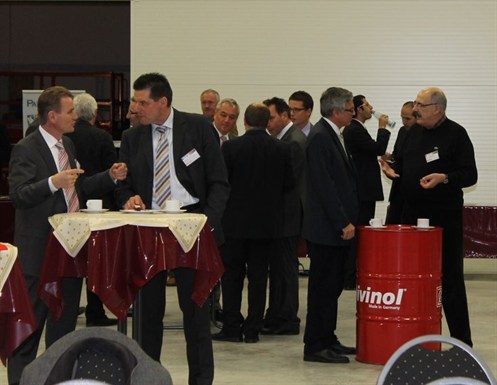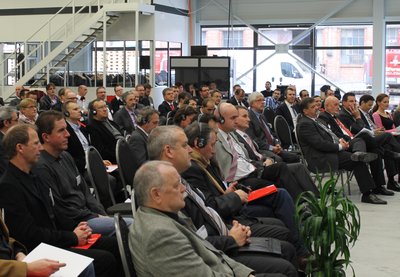Some 120 distributors and customers attended the inauguration of the new low migration facility
German UV ink specialist, Zeller+Gmelin, has been leading the way in low migration research and development. In November, the company went one step further when it opened a dedicated low migration plant at its headquarters in Eislingen, near Stuttgart. Neel Madsen attended the inaugural event.
On November 29, Zeller+Gmelin gathered over 120 customers, distributors and the press for the opening of a new purpose-built low migration (LM) ink production facility. The company specialises in UV inks for the printing of food packaging and has made the decision to increase this focus by separating the production of LM inks to ensure 100% compliance with industry demands and various legislative measures. The day was framed by a number of informative presentations from both staff, co-suppliers and industry experts, including IST Metz and ESI Energy Sciences Incorporated.
Requirements
The debate on low migration inks is not a new one, but the importance of the company’s decision was emphasised by yet another food packaging related scare, namely the recent incidence of minerals oils found in chocolate in advent calendars in Germany. The chocolate may or may not be safe to eat, but the fact that the media was reporting on the findings of the German consumers group, Stiftung Warentest, puts more pressure on food packaging manufacturers and everyone involved in the value chain.
The number of legislative measures concerned with the safety of food packaging is increasing. Germany is currently following in the footsteps of Switzerland and preparing an ordinance on printing inks, while existing EU regulation, EuPIA guidelines and the Nestlé Guidance Note already lay out recommendations and rules to be followed.
But there are other demands to take into account when producing LM inks. Not only do they have to conform on a legal basis, they also have to perform on press and be commercially viable for the food packaging manufacturer. It is worth noting that in Germany and Switzerland, 35% of all printing inks sold are now LM. This number has doubled since 2009 and Z+G is planning further expansion to keep up with demand.
As regards performance, the inks must be matched to the press speed, have the right adhesion, flow and curling properties, be scratch resistant, and most importantly to brand owners, match the colour requirements. The price and availability of raw materials influence the cost of producing LM inks and users need to look at minimising waste to keep costs down. In his presentation, managing director, Marcus Ruckstädter said that generally the colour standards of LM and non LM inks are identical, but that issues arise in the case of colours such as rhodamine red, reflex blue, blue 72, purple and violet, because fanal pigments are not allowed in LM inks.
Trends and drivers
‘The global packaging market is worth in the region of $600-700 billion,’ said Thomas Reiner of Bernd & Partners, a packaging consultancy firm, which works with numerous global brand owners and blue chip companies. Mr Reiner continued, ‘It is necessary to understand what is driving this market, what the trends are. The world is changing and we need to change with it.’ His presentation looked at market sectors and growth, changes in population and the new political world order, consumer trends and globalisation.
‘By 2040, 50% of all households in Germany will be single households,’ he explained. ‘And by 2020, most people in Germany will be between 50 and 65. Even today they present 1/3 of the buying power.’ This change in the way we live and how long we live will naturally have an impact on packaging as portion sizes will decrease, while labels will need to be printed with larger type and packaging design will need to adapt to the ageing population.
Mr Reiner went on to stress the importance of being pre-emptive in your approach and set trends. He also recommended finding your focus. ‘You can’t be everything to everybody. You need to make a decision on where to grow. Profile your customers and adapt quickly.’ Producing quality is no longer enough, but needs to be supplemented by innovation and also bring sustainability into the equation. Continued innovation is vital to survival as the window of opportunity to build your market gets ever smaller. It is estimated that over 70% of new German products will be copied within 10 weeks of launch which gives new brands very little time to establish themselves in the consumer’s mind.
Open heart surgery
For printers considering using LM inks in their production, there are a number of issues to address. GundlachLOGO (Logo Etiketten GmbH) is one of Z+G’s customers which has recently changed its entire production to low migration, and managing director, Frank Neumann, was happy to share the company’s experiences with the audience.
Part of GundlachGruppe Bielefeld, the company has 100+ employees on two sites and a turnover of €140 million. It offers flexo, screen, offset and letterpress printing of self-adhesive labels, shrink sleeves and flexible packinging. In order to safeguard the company’s business and future proof production, the decision to go for a full conversion to LM inks was made.
‘For a small company like ours, it didn’t make financial sense to run two ink systems,’ said Mr Neumann. ‘I also didn’t want to try to understand the legal jungle and we wanted to change before legislation forced our hand.’ Even so, the decision was not undertaken lightly and numerous risk assessments, discussions, cost analyses and customer requirements were taken into account.
The implementation process took almost a year with the company’s presses converted one at a time, restandardised and a monopigmented ink system put in place. This was complemented by total integration into an existing ERP system and precise calculations for each job to avoid costly ink waste as well as reformulation of all inks. The company worked closely with Z+G during this phase and also brought in its UV curing suppliers for advice.
Mr Neumann concluded, ‘This was not a smooth process and you have to be prepared for problems. Make sure your employees are onboard and support the decision. There will be deviations in colour which you have to sell to your customers, but in the end, you will be breaking new barriers, be a trendsetter ahead of the competition and win new business. LM inks are here to stay.’

From lamp oil to inks
Z+G was founded in 1866 by Albert Zeller and Paul Gmelin and initially produced lamp kerosene from Swabian oil shale. It then progressed to the manufacturing of machine lubricants and spindle oils, cylinder oils and grease. A steady process of diversification followed via the creation of the chemistry division and finally the ink division some 80 years ago. The company has focused on UV inks since 1970 and is still privately owned with a turnover of €230 million and 880 employees worldwide.
Although the company still supplies lubricants to the motor industry, the printing inks division accounts for 60% of the annual turnover with a steady growth of 10% pa with only a small dip in 2008/09. Sales and marketing manager, Andreas Mahlich, said, ‘We are very proud of our independence and our aim is to be present in all markets worldwide. We don’t want to be followers but leaders and we are on our way to becoming a green company.’ The facility at Eislingen re-uses energy emissions for heating and will have solar panels installed next year.
Headed up by Dr Heinz Schweiger, an analytical centre was established three years ago at Eislingen for the development of LM printing inks and quality control of raw materials. Here assessment of test samples takes place using gas chromatography and liquid chromatography – mass spectrometry. The LM ink series is further sent for independent analysis and evaluation for maximum product security.
Today, Z+G offers a full range of UV LM inks and varnishes for flexo, letterpress, offset, waterless offset and EB offset printing. Its Uvaflex Y71 series is available for flexo printing of labels, plastic containers, flexible packaging and metal decoration. Future developments includes UV LED inks and varnishes, UV LED curable LM inks and varnishes and OptiScreen flatbed screen system for tubes and rigid plastic products. The company is also investigating whether UV digital inks (UV inkjet) can be formulated to low migration standards.
More presentations during the event were given by Volker Selg from IST Metz GmbH who spoke about the current status of UV technology including UV LED curing; Urs V Läuppi from ESI Energy Sciences Inc who covered EB curing; and Volker Michel from Füll Systembau GmbH who described safe production with ink dispensing systems.
The successful inauguration was celebrated in the evening with dinner at a local micro brewery and restaurant.






